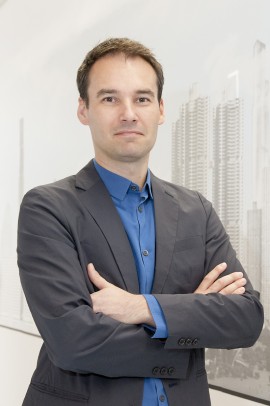Alexander Eisenschmidt explores phantom cities

Alexander Eisenschmidt, curator of “City Works: Provocations for Chicago’s Urban Future.” Photo: Roberta Dupuis-Devlin/UIC Photo Services (click on image for larger file size)
Sometimes the building that gets designed but never built turns out to be more interesting than the one that actually does go up.
That’s one of the themes in “City Works: Provocations for Chicago’s Urban Future,” an exhibition organized and curated by Alexander Eisenschmidt, assistant professor of architecture, on view through Sept. 29 at the Expo 72 Gallery, 72 W. Randolph St.
Models in the exhibition are surrounded by a 160-foot-long panorama of unbuilt designs.
“It’s a parallel city, a phantom city, that is not real but does exists in the sense of our architectural consciousness,” Eisenschmidt said.
Visitors who download the “Phantom City” app can explore the different proposals throughout the city.
For example, Adolf Loos’ entry for a 1920s competition to design the Tribune Tower features a Doric column on a massive podium.
“Around the world, architects think of Loos’ design and not the building that was constructed,” Eisenschmidt said.
Why were so many designs never realized as actual structures?
“Maybe some worked better as visionary projects,” Eisenschmidt. “They were never intended to be literal blueprints.
“Other times, the technology was not as advanced as would have been required.
“Some were so outlandish they became provocations, not only for architecture but for urban culture.”
The panorama includes fanciful modern designs that will never — could never — be built.
These include Stanley Tigerman’s “Titanic,” representing Mies van der Rohe’s Crown Hall at IIT, sticking out of Lake Michigan on a slant as if sinking.
And Greg Lynn’s “Stranded Sears Tower,” imagining the skyscraper’s nine vertical tubes, or “strands,” as if melted into a mound of steel pasta.
Surrounded by the panorama, created by Eisenschmidt, are four models designed by Chicago architects or firms:
• Studio Gang’s “Reclaiming the Edge,” featuring a series of freshwater inland lagoons
• “Free Water District,” by UrbanLab/Sarah Dunn and Martin Felsen, built around water-focused industries. Dunn teaches at UIC.
• Tigerman’s “Displacement of the Gridiron with the Cloister,” which looks at the impact of large architectural forms on the city
• “The Available City,” by UIC’s David Brown, envisioning new buildings on Chicago’s 15,000 city-owned vacant lots, reclaiming space equal to twice the size of the Loop.
As he planned the exhibition, Eisenschmidt thought “it should not be just a document of Chicago’s visionary past but also a platform for looking at the future,” he said.
Although its focus is Chicago, the project was first shown last year at the Venice Biennale in Italy.
“It’s the most important architectural venue in the world,” he said. “It gave us the opportunity to put Chicago on the map.”
Eisenschmidt is working on a book to be called The Good Metropolis.
“It looks at the productive tension between the modern city and architectural form,” he said. “How the city’s most unconventional areas could become starting points for architectural explorations.”
For his Ph.D. dissertation, Eisenschmidt studied Berlin circa 1910.
“It was primarily a historical exploration but also made connections to the here and now, making the point that cities are stranger than fiction,” he said.
Eisenschmidt’s writings have appeared in Architectural Research Quarterly, The Architect’s Newspaper New York and the Journal of the Society of Architectural Historians.
He is the author and editor of City Catalyst: Architecture in the Age of Extreme Urbanisation and co-editor of the forthcoming book Chicagoisms.
Eisenschmidt grew up in Leipzig, Germany. He earned a diploma from HTWK Leipzig, master’s degree from Pratt Institute in New York, and Ph.D. from the University of Pennsylvania.
He lives in an architecturally significant building, Bertrand Goldberg’s Marina City, with his wife, Maria Gaspar, an artist who teaches at the Art Institute.
He is a co-founder and partner in the design practice Studio Offshore.
Its name suggests that “it is a collaborative practice with people in different cities and countries,” he said.
“It’s not based in a particular place.”
